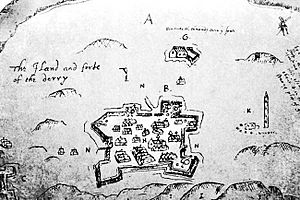Cahir O'Doherty facts for kids
Sir Cahir O'Doherty (born in 1587) was a powerful leader in Gaelic Ireland. He was the last main chief of the O'Doherty family and the Lord of Inishowen, an area in what is now County Donegal. Cahir was known as the "Queen's O'Doherty" because he was loyal to the English Crown during a big conflict called Tyrone's Rebellion.
After the war, Cahir wanted to work for the royal family. He tried to get a job with Henry Frederick, Prince of Wales. However, he started having disagreements with English officials in Ireland. These included Sir Arthur Chichester, who was like the main governor, and Sir George Paulet, the governor of Derry. In 1608, Cahir started O'Doherty's Rebellion. He took over the town of Derry from Paulet and burned it down. Cahir was later killed in a battle at Kilmacrennan, and his rebellion quickly ended.
Cahir O'Doherty's Early Life
Cahir was the son of Sir John O'Doherty, who was the leader of the O'Doherty family and ruled Inishowen. Cahir had two younger sisters: Rosa, who married two important men, and Margaret. When Cahir's father died, Cahir was only fourteen. It took him a few years to fully take control of his family's lands. His foster father, who helped raise him, was Phelim Reagh MacDavitt.
Cahir was made a knight by Lord Mountjoy, an English leader. For a while, Cahir seemed to get along well with the English government. He had a strong supporter in Sir Henry Docwra, who was the first governor of Derry. Cahir also married Mary Preston, whose father was a leading noble from the Pale, an area in Ireland controlled by the English. This marriage connected him to powerful families.
Cahir O'Doherty and Niall Garve O'Donnell were two important Gaelic chiefs. The English Crown hoped to keep them on their side by being fair and moderate. For some time, this plan seemed to work.
O'Doherty's Rebellion Begins
Sir Cahir O'Doherty got involved in some secret plans after a big event called the Flight of the Earls, when many Irish chiefs left Ireland. He was also angry because his lands were being taken away for the Plantation of Ulster. This was a plan to settle new people from England and Scotland in Ireland.
In 1608, Sir Cahir attacked and burned the town of Derry. His foster-father, Felim Riabhach McDavitt, killed Sir George Paulet, the governor of Derry. Cahir had argued with Paulet many times. Some people said that Paulet had made Cahir angry by insulting him and even attacking him.
It's not completely clear why Cahir started the rebellion, or why he chose that specific time. The Irish government had actually just decided to give him back the rest of his lands. Perhaps getting revenge on Paulet was reason enough for him.
Cahir O'Doherty was killed during the Battle of Kilmacrennan. He was fighting against an English force led by Lord Powerscourt. His remaining soldiers retreated and made a final stand at the Siege of Tory Island.
Cahir O'Doherty's Legacy
After the rebellion, Niall Garve O'Donnell and his son were arrested. They were sent to the Tower of London in England, where they later died.
A historian named Brian Bonner said that in Inishowen, where the old traditions were kept, Cahir was seen as a great hero of the Gaelic people. He was loved and honored, and his memory was respected. Being related to his family was a special privilege. However, over time, his memory has faded. English-speaking people in the area sometimes have a different view of him, seeing him as the "villain" who attacked Derry. This is a bit strange, as Cahir fought to protect the ancestors of those very people.
In the 1990s, the Chief Herald of Ireland started to recognize descendants of the chiefs of some old clans. This was based on the English system where the oldest son inherits the title, not the older Irish way of choosing a leader. Dr. Ramón Salvador O'Dogherty claimed to be a descendant of Cahir O'Doherty's brother, Sean.
In July 1990, the O'Dogherty clan had a gathering. Ramon Salvador O'Dogherty was named "Chief of the Name" in a ceremony. He received a traditional white wand and a sword that Cahir O'Doherty was said to have used when he died in battle in 1608.



